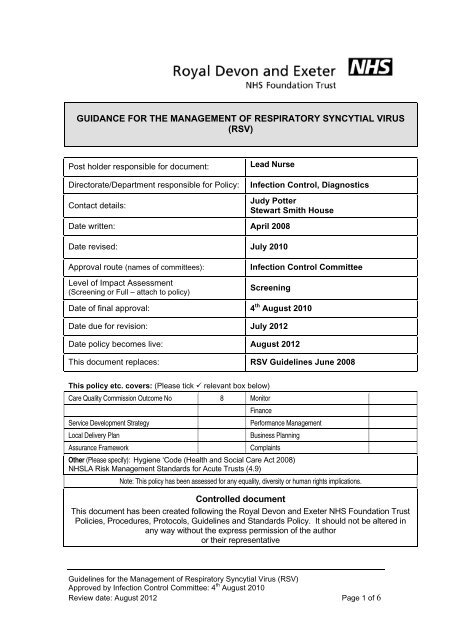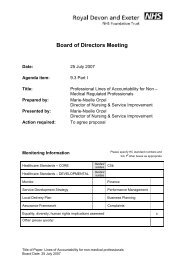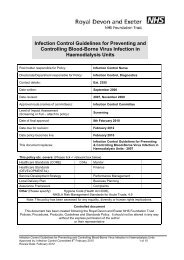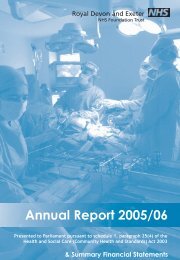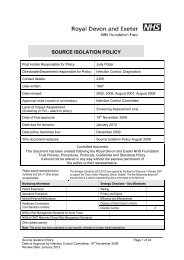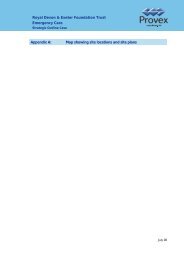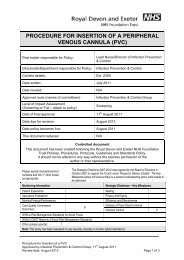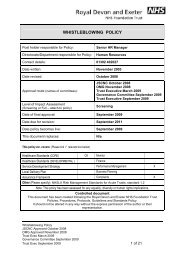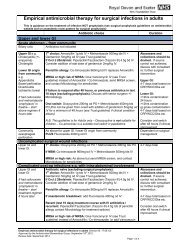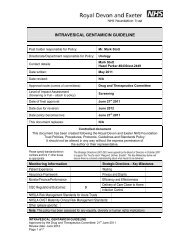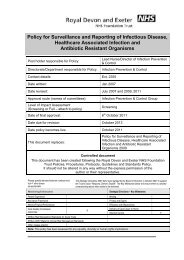Respiratory Syncytial Virus (RSV) - Royal Devon & Exeter Hospital
Respiratory Syncytial Virus (RSV) - Royal Devon & Exeter Hospital
Respiratory Syncytial Virus (RSV) - Royal Devon & Exeter Hospital
Create successful ePaper yourself
Turn your PDF publications into a flip-book with our unique Google optimized e-Paper software.
1 General InformationFor most people respiratory syncytial virus (<strong>RSV</strong>) infection causes a mildrespiratory illness. Those who are at risk, for example immunocompromisedpatients and those with chronic heart and lung conditions, may develop asevere respiratory illness and pneumonia. <strong>RSV</strong> causes bronchiolitis in infantsand it is the commonest cause of hospital admissions due to acute respiratoryillness in young children (HPA, 2010). Premature infants and neonates are atparticular risk for severe illness and respiratory complications following <strong>RSV</strong>infection.<strong>RSV</strong> is a paramyxovirus, an enveloped RNA virus, which is unstable in theenvironment. It can remain infectious on surfaces or objects for about 4 to 7hours, and survives on unwashed hands. Hand hygiene using alcohol handrubs or, washing with soap and water, removes it effectively.Epidemics of the virus occur annually and tend to start in November orDecember and last for 4 to 5 months. It is estimated that over 60% of childrenhave been infected by age one year and 80% by age two. Immunity is shortlived and relatively ineffective, therefore recurrent infections with or withoutsymptoms are likely to occur throughout life.2 Patient Risk GroupThose most at risk of developing severe illness due to <strong>RSV</strong> are the veryyoung, aged one year and under, and the elderly. Premature neonates orchildren with underlying cardiac or chronic lung disease are at particular risk.3 Identification of Infection and DiagnosisCommon symptoms are similar to a cold including coughing, sneezing, nasalcongestion, rhinitis and sometimes fever. Bronchiolitis is seen in infants.Children can also develop ear infections and croup.Diagnosis is based on clinical symptoms. Laboratory confirmation of <strong>RSV</strong> canbe achieved by obtaining a naso-pharyngeal aspirate (NPA) in babies orthroat swab, for immunofluoresence and PCR.4 Prevention and TreatmentThere are no vaccines against <strong>RSV</strong>. Children at high risk from infection maybe offered passive immunity with a monoclonal antibody preparation(Palivizumab).For mild disease no specific treatment is required except that of symptommanagement. For more severe cases nursing support, oxygen therapy andmechanical ventilation may be required. Ribavirin may be used in life –threatening infection, but evidence of effectiveness is limited.Guidelines for the Management of <strong>Respiratory</strong> <strong>Syncytial</strong> <strong>Virus</strong> (<strong>RSV</strong>)Approved by Infection Control Committee: 4 th August 2010Review date: August 2012 Page 3 of 6
informed at the earliest opportunity. The occupants may then be isolatedseparately or nursed as a cohort.6.2 Management of <strong>RSV</strong> on the Neonatal Unit (NNU)Neonates and premature infants are especially susceptible to severe <strong>RSV</strong>infection, which can also result in long term respiratory sequelae. <strong>RSV</strong>infection discovered on the NNU therefore is especially serious and requiresrigorous control.In the event of an outbreak or suspected outbreak of <strong>RSV</strong> on the NNU, theunit will be closed to admissions. An urgent outbreak control meeting will beconvened by the infection control team to confirm control measures includingunit closure and the possible use of prophylaxis.The following precautions will apply unless otherwise determined.• Visiting to the NNU will be restricted to PARENTS ONLY.• Parents of symptomatic children must restrict their movement aroundthe NNU and their contact with other parents and children within andoutside of the unit to reduce the risk of potential transmission.• If a symptomatic neonate has siblings on the unit then ensure parentsalways see non infected baby first.• All parents should be informed of visiting restriction and the rationalefor such actions during NNU closure.6.3 Single room isolation for suspected and confirmed cases• Source isolation sign on doors.• Gloves and apron to be worn for all ‘hands on’ care and cleaning incubicle. Parents need only wear aprons. Hand to be decontaminatedafter removal of gloves and aprons before leaving the cubicle andagain after vacating the cubicle. All non essential equipment and stockto be removed from cubicle.• Inside cubicle- Gloves all sizes- Disposable aprons available in case a change is required- Alcohol hand gel must be available and used- Bins with liners for infected linen and clinical waste- Sharps bin- Thermometer• Outside cubicle- Disposable aprons- Alcohol hand gel- Notes, folders and charts- Baby monitorGuidelines for the Management of <strong>Respiratory</strong> <strong>Syncytial</strong> <strong>Virus</strong> (<strong>RSV</strong>)Approved by Infection Control Committee: 4 th August 2010Review date: August 2012 Page 5 of 6
• Should equipment be taken into the cubicle, it must be decontaminatedupon exit.• Suspected <strong>RSV</strong> cases are screened by obtaining NPA samples. Threesamples are required at weekly intervals to ensure clearance ofpositive. Once clearance has been established and the medical staffhave determined that no infective cause for symptoms exists, isolationprecautions can cease.• Cleaning of source isolation rooms must be done last, after cleaning inother areas. Where a confirmed case is considered no longerinfectious, the cubicle must be terminally cleaned before it can bereused.• Explain to parents the reason for and details of isolation and wherepossible its anticipated duration. Parents should be given writteninformation.7. ReferencesHPA, (2010) <strong>Respiratory</strong> <strong>Syncytial</strong> <strong>Virus</strong> (<strong>RSV</strong>)Available athttp://www.hpa.org.uk/Topics/InfectiousDiseases/InfectionsAZ/<strong>Respiratory</strong><strong>Syncytial</strong><strong>Virus</strong>/HPA, (2008) <strong>Respiratory</strong> <strong>Virus</strong>es QSOP 60 Issued by standards Unit,Evaluations and Standards Laboratoryhttp://www.hpa-standardmethods.org.uk/documents/qsop/pdf/qsop60.pdfGuidelines for the Management of <strong>Respiratory</strong> <strong>Syncytial</strong> <strong>Virus</strong> (<strong>RSV</strong>)Approved by Infection Control Committee: 4 th August 2010Review date: August 2012 Page 6 of 6


